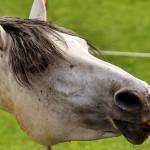Horse Treats: What Does Your Horse Prefer?

Nearly half of all horse owners routinely offer treats to their horses. How do these owners select treats, based on their own senses or those of their horses? A recent study set out to evaluate the appeal of two different treats from contrasting perspectives, from that of horses and that of humans.1,2
Two treats were used in this study: a cinnamon-flavored, flax-based, disc-shaped treat and an apple-flavored, oat-based textured treat. Ten stock-type horses were used in the preference trial. The treats were placed in identical rubber feeding pans, each with an olfaction plate (a fitted lid with holes) that allowed the aroma of the treats to escape. The lid was removed after 15 seconds and consumption began; the consumption period ended when one treatment was finished. A trained observer recorded first treat sniffed; first treat consumed; first action (sniff vs. consume); aversive behaviors, such as treat refusals, dropping treats from the mouth; and excessive salivation.
Twenty-three human participants rated the two treats on physical attributes, like appearance, size, texture, and aroma, using a nine-point scale, with one denoting extreme dislike and 9 signifying extreme like. Purchase intent was then evaluated on a five-point scale, with one denoting no intent to purchase and 5 signifying definite purchase.
While horses did not prefer one treat over another in terms of first sniffed, consumed, or finished, researchers noted positive correlations for first sniffed and consumed as well as first consumed and finished. The human participants proved far more opinionated, rating the apple-flavored treat lower in appearance, texture, size, and purchase intent than the cinnamon-flavored one.
What does this mean? According to these researchers, “these data indicate that consumer acceptance and purchase intent of horse treats do not accurately reflect horse preferences.” One explanation for this disparity could be simply that humans depend on visual cues far more in food selection than do horses, which rely more heavily on aroma and taste.
The nutritional content and quantity of treats offered should be considered as part of the total diet, particularly for horses suffering from metabolic disease.
1APPA. 2018. The 2017-2018 APPA national pet owners survey debut. Greenwich, CT. American Pet Products Association.
2Francis, J.M., K.A. Thompson-Witrick, and E.B. Perry. 2021. Palatability of Horse Treats: Comparing the Preferences of Horses and Humans. Journal of Equine Veterinary Science 99:103357.








